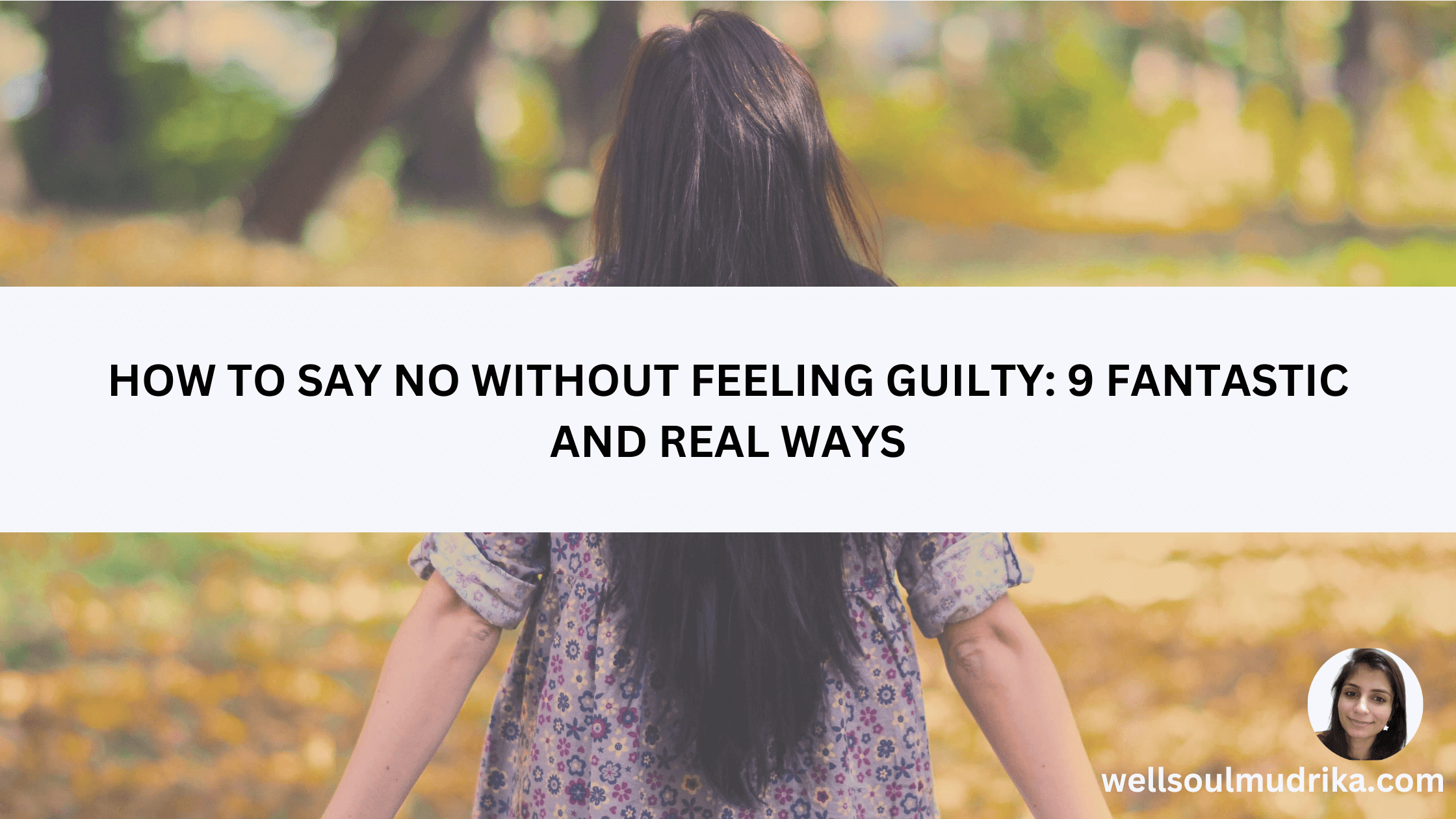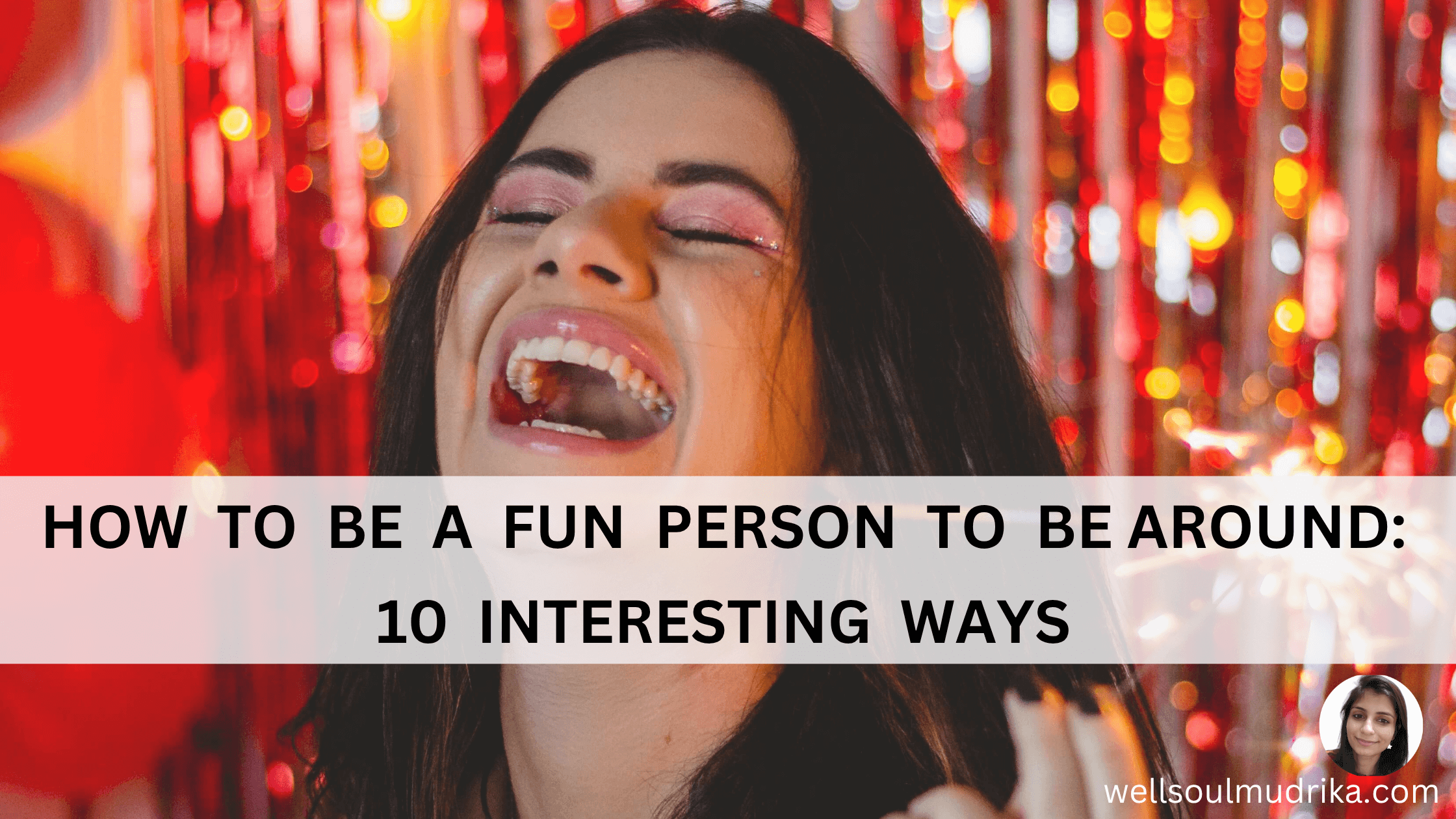Always saying yes when you want to say no? Learn how to say no without feeling guilty with simple tips and real-life examples to protect your time and energy.

Imagine your calendar is jam-packed, you are low on energy, and someone asks you for a favor. Before you even realize it, you’ve said “yes” again. Later, you’re sitting there wondering, “Why did I agree?” Feeling overwhelmed, stretched too thin, and maybe even a little guilty.
This scenario is all too common. If you’re an introvert like me, this can feel even tougher. I have been there and felt that..Saying no might seem like a huge obstacle because you want to avoid conflict or disappointing others.
So many of us say yes out of fear of hurting feelings or seeming selfish. But consistently prioritizing others’ needs over our own can lead to burnout, resentment, and a lower sense of self-worth.
Learning how to say no without feeling guilty is simply about protecting your mental health and creating healthy boundaries that let you show up as your best self. And this blog is all about the challenges of saying no and learning how to say no without feeling guilty or awkward. Keep reading!
Why Is It So Hard to Say No?
Before you learn how to say no without feeling guilty, you need to understand why it is so hard for you to say no to others. Well, saying “no” can be difficult due to various psychological and social factors as follows:
- People-pleasing habits: There is an innate desire in us to be liked and accepted, so-called “people pleasing”. This habit makes you agree to requests even when it’s inconvenient for you.
- Fear of conflict: Some avoid saying “no” to prevent potential disagreements or confrontations. Of course, nobody wants unnecessary conflicts that can be avoided by saying yes. Right?
- Social conditioning: Our cultures and societies teach us to always put others first, so saying no can sometimes feel wrong or rude.
Common myths, such as “Saying no is selfish” or “I’ll hurt their feelings,” increase the difficulty.
However, as per the study published in the Journal of Personality and Social Psychology, 2024, it was found that we often overestimate the negative consequences of declining social invitations. We think that it would upset the inviter or harm the relationship, but in reality, most people are actually more understanding than we expect. So, we should stop being negative all the time.
So, setting boundaries is a sign of self-respect and can lead to healthier relationships. And that’s why learning how to say no without feeling guilty is an essential skill now.
When Should You Say No?
Recognizing when to say “no” is a part of learning how to say no without feeling guilty for maintaining balance and well-being.
Here are a few signs that show you should decline and say no without guilt:
- You’re already feeling stretched too thin and need a break.
- You start feeling a little annoyed or frustrated about saying yes.
- You don’t have enough time for the things that really matter to you.
- The request doesn’t really fit with what’s important to you right now.
- Saying yes would cut into your much-needed rest or “me time.”
- It would keep you from spending quality time with the people or things you care about most.
Taking time for self-reflection helps you recognize your limits and triggers, making it easier to get out of your comfort zone by setting healthy boundaries.
When you understand what drains your energy, you can choose where to focus your time and say no without feeling guilty. In fact, research from the Mayo Clinic shows that clear boundaries reduce stress and boost overall happiness, while poor boundaries often lead to anxiety and overwhelm.
Why Learn How to Say No Without Guilt?
Now, let’s quickly get into why there is a need to learn how to say no without feeling guilty. Well, when you confidently say “no,” you affirm your self-worth and create space for opportunities that truly matter to you.
You reclaim your time and energy, which further leads to:
- Improved mental health
- Stronger personal boundaries
- More time for priorities
- Greater self-confidence
- Reduced stress and anxiety
- Better work-life balance
Saying no doesn’t mean you don’t care. It’s an act of self-care. (Want to explore the types of self-care that support this? Here’s a guide that breaks it down.)
It isn’t selfish to set boundaries. It’s selfish of others to expect you to be selfless.
A gracious decline isn’t a rejection of the person. It’s a recognition that you don’t have the energy for this right now.
Saying no doesn’t mean you don’t care. It’s an act of self-care.
It isn’t selfish to set boundaries. It’s selfish of others to expect you to be selfless.
A gracious decline isn’t a rejection of the person. It’s a recognition that you don’t have the energy for this right now.
How To Say No Without Feeling Guilty: 9 Fantastic Ways For Personal Growth
Learning to say “no” without guilt is like building a muscle. The more you practice it, the stronger your boundaries become. You now know the when and why of learning how to say no, right?
Let’s get into the 9 easy ways of how to say no without feeling guilty. I promise you can start using them from today itself. Ready?
1. Be clear and kind at the same time
One of the most effective ways to say no without feeling guilty is to be clear and compassionate at the same time. Saying no doesn’t mean being cold or dismissive.
We often feel guilty when we try to sugarcoat our no or avoid it altogether, only to agree to something we regret later. But honesty, when paired with kindness, not only respects your own needs, it also respects the other person’s right to know where you stand.

Think of this like choosing clarity over comfort. Just be honest in a warm tone.
Example:
“I really appreciate you thinking of me, but I won’t be able to take this on right now.”
That one sentence does three things:
- It acknowledges the person’s effort.
- It clearly states your boundary.
- It avoids unnecessary guilt.
So, you can say no without being mean.
| Always remember→ You’re not rejecting the person, you’re simply declining the task or request. People may not love hearing no, but they’ll respect you for being genuine. |
2. Use the “Sandwich” technique
This one’s a classic because it works. The “sandwich” method helps you say no in a way that softens the blow. The structure is simple:
Positive statement → No → Encouraging or warm ending
Why does this work? Because it keeps the tone positive. You’re still saying no, but you’re doing it with grace.
Example:
“Thanks for inviting me to speak at the event! I’m not able to commit this time, but I really hope it goes amazingly well.”
Did you notice? The positive framing before and after makes it easier for the other person to hear the ‘no.’
It reassures the other person that you’re not rejecting them personally. You’re just setting a boundary in a way that maintains warmth.
Pro Tip: Use this when the relationship matters more than the request, or when you want to keep future opportunities open without feeling pressured now.
3. Ditch the over-apologizing
When you’re learning how to say no without feeling guilty, remember you don’t have to keep apologizing over and over. Saying sorry too much can make your “no” sound uncertain and might even make you feel worse. A simple, confident response is all you need.
People may interpret “maybe” as “yes,” and then feel disappointed when you don’t follow through.
When you stop overexplaining, you send a subtle message: your time and energy matter, and that’s okay.
Example:
“I won’t be able to join this weekend, but I hope it goes well!”
This is better than:
“Umm… maybe, I’ll see how I feel.”
The second one leaves both of you hanging. So, always close the loop with grace.
4. Offer an alternative only if you genuinely want to
Many of us have a people-pleasing habit. So we say no… and then instantly feel compelled to add a “but I can do XYZ instead!” That’s fine, if the alternative works for you. Saying no doesn’t mean you owe them a solution. Offer alternatives only if you want to, when it truly fits your schedule, energy, and desire.
Example:
“I can’t commit to joining the meeting, but I’d be happy to share a few ideas by email next week.”
That way, you’re showing willingness, without compromising your boundaries or self-sacrificing. It’s a win-win.
Sometimes, your no is the whole sentence. If you’re not available, you’re simply not available. And that’s okay.
5. Set clear boundaries with “I” statements
When learning how to say no without feeling guilty, how you phrase it makes a huge difference. For this, “I” statements keep the focus on your feelings and choices, not on blaming or defending. It makes you own your decision.
Compare this:
“You always ask me last minute!” or, “I need more notice to take this on.”
“I” statements show that you are sharing your truth and not pointing fingers or attacking them.
This increases the understanding while avoiding the conflict.
6. Practice saying “no” to small things.
I get it. You can’t just go and say no to a big ask, like turning down a job opportunity or a close friend’s request. Learning how to say no without feeling guilty requires you to start small.
Start by saying no to small requests when it doesn’t feel risky, like:
- Declining food plans
- That extra Zoom meeting
- A group chat you don’t have energy for
Example:
“I’m skipping this call as I need some screen-free time.”
or
“I think I’ll pass on the movie as I need a quiet evening.”
It sounds simple, but it rewires your habit of always saying yes. Over time, you’ll become more comfortable with the act of turning things down.
Also Read: 10 Important Things To Quit To Simplify Your Life
7. Buy time when you feel pressured
Have you ever said yes too quickly, only to regret it later? That knee-jerk “Sure!” often comes from panic, guilt, or a need to please. One of the simplest yet most powerful ways you can use when learning how to say no without feeling guilty is the pause.
Buying time gives you space to respond instead of react.
Example:
“Let me check my schedule and get back to you by tomorrow,” or “Let me think about it.”
Taking a moment helps you make a thoughtful choice rather than giving in to pressure.
8. Acknowledge their feelings, then hold your ground
When you’re learning how to say no without feeling guilty, it’s okay to show you care, especially if it’s someone you love or work with. Acknowledging their feelings can ease tension.
But don’t let empathy erase your boundary.
Example:
“I know this is important to you, and I wish I could help, but I really need to prioritize my other commitments.”
You’re showing care without changing your answer.
In case they push back, you can stay calm and repeat your boundary.
“I understand, but my answer is still no.”
Remember, it’s okay to validate how someone feels. Just don’t confuse empathy with responsibility.
9. Remind yourself why saying no matters
Remember, how to say no without feeling guilty is about protecting your time and energy. Each “no” is a “yes” to your own priorities.
Next time guilt creeps in, ask yourself: “If I say yes to this, what am I saying no to for myself?”
Example (internal):
“Saying no to this project means I’ll have time to finish what really matters to me this week.”
This mindset shift turns guilt into empowerment.
Every time you say no to something that doesn’t align, you’re saying yes to your time, your peace, your goals, and your rest.
If you liked reading so far, pin it to save this for later.
Wrap Up: How to Say No Without Feeling Guilty
I hope you have now learnt how to say no without feeling guilty or awkward. The key is to be honest with yourself and others about what you can realistically handle. Practice clear and kind ways to say no, and remind yourself that protecting your time is a form of self-respect.
Over time, saying no will feel less like a challenge and more like a natural part of caring for yourself. Start today by saying no to one thing that doesn’t serve you and do it guilt-free.
What will you say no to right now? Share below, I would love to know.
FAQs
1. Why do I feel so guilty saying no?
We’re often taught to equate saying no with being rude or unhelpful. That’s why we feel so guilty. Social conditioning, people-pleasing habits, and fear of rejection all play a part. But guilt isn’t proof you’re doing something wrong. It’s just a signal you’re breaking old patterns.
2. How do I say no without hurting someone’s feelings?
Start with appreciation, be clear and kind, and offer empathy if needed. You can acknowledge their feelings without changing your answer. Example: “I understand this is important to you, but I need to say no right now, hope you can understand.”
3. Is it okay to say no at work?
Absolutely. As long as you communicate clearly and respectfully, saying no at work can protect you from burnout. Use “I” statements and offer context: “I’m currently at full capacity, and taking this on could affect the quality of my work.”



